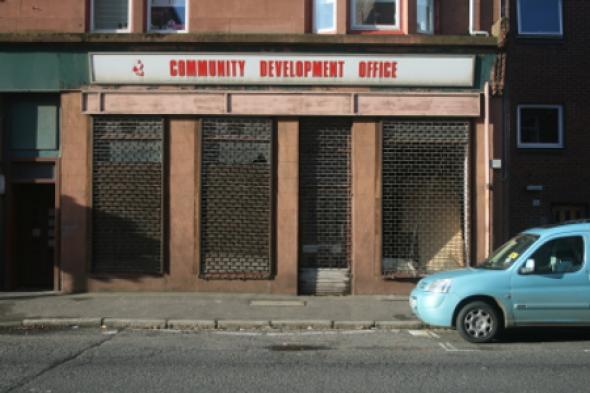CG 2014: Formulary for a Skewed Urbanism
Using the 2014 Commonwealth Games as a launch pad for further analysis, Neil Gray unmasks the dehumanising and exploitative realities behind the logic of urban regeneration strategies in Glasgow
The Games offer our country a chance to advertise to a global audience of over 1 billion people. Glasgow is an incredible city and Scotland is an unforgettable country. The more people who get the chance to see this the more we can grow in the future.
- Glasgow 2014 Ltd1
On Friday 9 November 2007, amidst saltire waving hysteria, the General Assembly of the Commonwealth Games Federation chose Glasgow as the host city for the 2014 Games. The Deputy First Minister, Nicola Sturgeon, of the Scottish National Party (SNP) captured the zeitgeist as imagineered by the ‘Team Glasgow' neoliberal consensus, albeit tinted with her own nationalist hue: ‘This will bring a host of benefits to Glasgow and Scotland, including everything from regeneration, job creation, inward investment and just a huge pride in being Scottish'.2 Between the often convergent claims of ‘Team Glasgow' and ‘Team Scotland', the Games have been declared an outstanding success five years before they've even begun. This should come as no surprise; the rolling out of Bread and Circuses is about the most coherent political strategy available to city regions under the external coercive power of neoliberal inter-urban competition. As a senior planning officer from Manchester Local Authority explained of Manchester's Commonwealth Games in 2002:
Once you adopt a strategy of pursuing sports-led urban regeneration, politically it is very difficult for it to be allowed to fail [sic], so what happens is that it gets declared a success, really irrespective of what happens on the ground.3
Mega sporting events are now routinely staged in ‘run down' areas of host cities and mobilised as both alibi and instrument for the ‘regeneration' of declining urban regions. The Commonwealth Games 2002 in Manchester and London's Olympic Games 2012 are paradigmatic examples in the British context. The notoriously deprived East End of Glasgow is the latest ‘urban frontier' to fall prey to this transparent property development strategy. The Games will take place over 12 days from 23 July to 3 August, 2014, and Glasgow 2014 Ltd - comprising the Scottish Government, Glasgow City Council and the Commonwealth Games Council for Scotland - is the organisation charged with overseeing the management of the event. While the figure routinely reported in the press is a downsized £350 million, in fact, an estimated £2 billion of public money will go towards the costs, including the construction of a new Indoor Sports Arena, a Velodrome, and an Athletes' Village, alongside supporting physical infrastructure.4 City boosters, meanwhile, claim the event will stimulate the building of 1,000 new homes, and create 1,000 permanent new jobs.
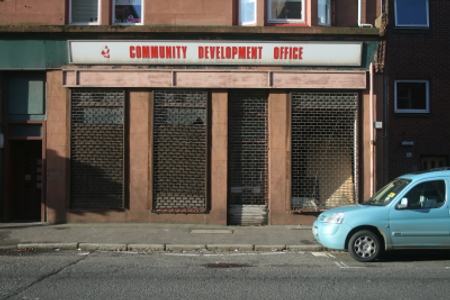
Image: Community Deveopment Office, Bridgeton, a key area in the Clyde Gateway proposals (all images courtesy of the author)
Glasgow's Commonwealth Games 2014 (CG 2014) cannot be adequately understood without grasping its relationship to wider waterfront regeneration ambitions along the £5.6 billion, 13-mile Clyde river corridor. The ‘return to the river' along a post-industrial, disinvestment valley around the city centre's financial district, is seen as a key priority in transforming Glasgow's image from recalcitrant Red Clydeside to, newly branded, ‘Glasgow: Scotland with Style'. While much of this development has taken place around geographically circumscribed areas in already developed city spaces, the Clyde Gateway Initiative in the East End, at 2,070 acres in size, is a potent ‘new urban frontier' - a potential land-grab of enormous proportions. To this end, the initiative aims to oversee £1.5 billion of private sector investment, 400,000 square metres of business space, 21,000 new jobs, 10,000 new houses, and a population increase of 20,000 people over 20 years. The rhetoric of ‘regeneration' in the area has pitilessly converged on ‘blight' and the (un)productivity of local land and labour as a justification for wholesale urban renewal.5 But the paternalist discourses attached to the regeneration script mask pernicious undercurrents: territorial stigmatisation, an ideological drive towards ‘flexible' labour markets and a continuing thrust towards private property development.
Imitation of Life
In the mid-'90s, Neil Smith pursued an argument that Frederick Turner's influential essay ‘The Significance of the Frontier in American History' (1893) had crucial resonance for critics of urban gentrification. Put simply, for Turner, the Western frontier was envisioned as ‘the meeting point between savagery and civilization'; each wave westward in the conquest of people and nature contributed to new enclosures of land, space and labour, part of a wider mission to civilize an unruly and uncooperative landscape. By the latter part of the American 20th century, Smith contends, Turner's imagery of wilderness and the frontier was being applied ‘less to the plains, mountains and forests of the West [...] and more to cities back East'. In the modern reconfiguration of frontier lines, many slums in major US cities were demarcated as ‘urban wilderness' in order to legitimise their removal through slum clearance and urban renewal.6
By the 1970s, this ‘discourse of decline' was accompanied by boosterist discourses of urban development through gentrification. By the 1980s these entrepreneurial discourses had intensified - the ‘urban jungle' would be put to the sword by a new breed of urban hero. In the Reagan era, ‘urban pioneers', ‘urban homesteaders' and ‘urban cowboys' were represented as the new ‘folk heroes of the urban frontier'. For Smith, the important conclusion to be drawn from these frontier discourses, is that they attempt to ‘rationalise and legitimate a process of conquest, whether in the 18th and 19th century American West, or in the late 20th century inner city'. Like a domestic form of Orientalism, the frontier motif encapsulates a host of accumulated symbolic meanings with embedded uneven power relations, including:
the social differences between ‘us' and ‘them', the historical difference between past and future, and the economic difference between existing market and profitable opportunity.7
The imagery of conquest and expansion associated with the frontier motif has taken a kicking in the current economic crisis, yet frontier imagery persists.8 One method for dealing with capitalism's problem of inherently crisis ridden over-accumulation is devaluation, and the frontier analogy - associated as it is with notions of blight, decay and wilderness - can help provide a ‘convenient incantation' for development strategies. If the frontier doesn't exist, the state will attempt to create it. The state's willingness to subject its property and land base to market rule, and its simultaneous requirement to manage and disperse native populations, accounts for the zeal with which it stigmatises certain people and certain places. By targeting urban working class populations as ‘less than social', and the ‘frontier' area as ‘not yet socially inhabited', the state attempts to juggle the political imperative of administering potentially recalcitrant local populations, with the entrepreneurial task of maintaining or creating the conditions for profitable capitalist investment. Glasgow East - with its large tracts of derelict land and deeply impoverished population - lends itself to this ‘discourse of decline'; a discourse that in turn represents ‘renewal' and ‘regeneration' as both natural and irresistible.9
A Time to Love and a Time to Die
The July 2008 UK parliamentary by-election in Glasgow East became a crucible for territorial stigmatisation. Traditionally a staunch Labour constituency, Glasgow East was typically represented as a potent symbol of what the Conservative Party have called Britain's ‘broken society', and thus an emblem of Labour's political failure. A previous visit by Ian Duncan Smith to the East End ‘inspired' the formation of Tory think tank the Centre for Social Justice, which developed the extremely derogatory term ‘Shettlestone man' to profile male individuals who make up the largest constituency in Glasgow's East End: ‘This individual has a low life expectancy. He lives in social housing, drug and alcohol abuse play an important part in his life and he is always out of work'.10 Disavowing any consideration of the historical and political construction of urban space under successive capitalist regimes, press and politicians instead embarked on an overwhelmingly negative assault on Glasgow East and its population. The area was variously described as ‘the hardest, poorest place in Britain'; ‘a ghetto ringed by some of the saddest statistics in Britain'; a ‘hell-hole'; a ‘welfare ghetto', and an ‘invisible' no-go zone. Worse, in a cruel conflation of place and people, the residents of the Glasgow East constituency - allegedly a ‘social disaster' where the ‘law of the jungle' prevails - were frequently described with unapologetic class hatred: ‘The people do not look good here. Often it is difficult to tell men from women, old men from older men [...] the locals have the blotchy pallor of cave-dwelling consumptives'.11
The not so hidden discourse behind all this vile rhetoric was an attack on welfare and the so-called ‘dependency culture'. David Cameron claimed the area was merely an extreme example of a wider British malaise, of ‘social breakdown' and ‘welfare dependency'.12 Ian Duncan Smith made his prescription for such advanced marginality perfectly clear: the people of Glasgow East need to get the ‘work habit'. The press lustily joined in with this chorus, fancifully claiming that Glasgow East, a post-industrial area hammered by decades of labour exploitation, sustained disinvestment, de-skilling, slum clearance, depopulation and retrenched welfare services, was serviced by ‘epic amounts of public money'. Glasgow East and its ‘welfare prisoners' were represented as ‘a hideous, costly social experiment gone wrong', that cost ‘billions to achieve'. Isn't Glasgow East proof, one journalist asked, of ‘just how utterly poisonous that sort of thing is?'13
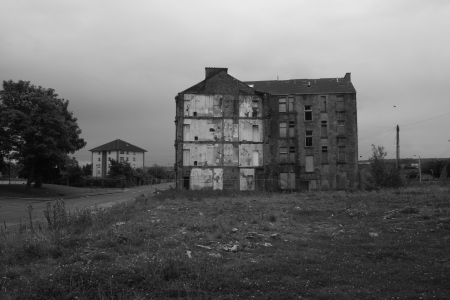
Image: Dalmarnock, site of the Commonwealth Games village
James Purnell's Welfare Reform White Paper proposals show, unsurprisingly, that Labour is entirely in concord with the Tory right. Smith's Centre for Social Justice boasts of how many of its recommendations are now advocated by Purnell on its website. David Freud, the investment banker who was Purnell's key advisor on welfare reform, meanwhile, has recently switched allegiance back to the Tories after previous tugs of war between the parties to enlist his advice on involving the private sector and voluntary groups in forcing the ‘jobless' into the labour marketplace.14 Purnell's proposed welfare reforms would see a Flexible New Deal (FND) that would refer claimants who'd been out of work for 12 months to incentivised private or third sector contractors, who would be paid by results to find them work. Added to this, Purnell proposes cuts in income support for single parents, cuts in incapacity benefit for disabled people, increased sanctions (benefit cuts) for benefit claimants, and the introduction of US-style workfare pilot schemes. The ‘moral capital' attached to business activity, despite evidence of its failure all around, is at Victorian levels, and the use of the private and voluntary sectors is ‘business as usual' for the Department for Work and Pensions. With £2 billion worth of contracts up for grabs over the next five years, the poverty industry is a growing business. Glasgow East, with its allegedly ‘unproductive' population (unproductive for whom?) is a key node of struggle in the proposed UK-wide transition from ‘welfare to workfare'.
The Magnificent Obsession
What we want to do is give people the chance to get back into the labour market, that's my understanding of a successful growing economy.
- Ian Manson, Clyde Gateway URC15
As far as I am concerned, business is Santa Claus, but there is still a passive attitude that sees it as a necessary evil rather than something that is fundamentally good.
- Richard Cairns, Glasgow Chamber of Commerce16
Glasgow City Council has set itself stringent targets to ‘overcome' what it sees as a GDP productivity gap. The City's Business Forum aspires to increase productivity by 43 percent and add another 50,000 to the employment register. Key strategy documents stress the need for Glasgow to move up the ‘value chain' in employment and employability terms, yet the Clyde Gateway Initiative and CG 2014 are unable to offer anything more than the same old low-paid, insecure service sector jobs. Nine out of ten jobs in Glasgow are in the service sector with even the City Council acknowledging that these jobs are in ‘lower paid and lower skilled services'.17 While the city dutifully adheres to the discredited creative economy thesis, it refuses to face up to the creative economy's mirror image: that of it's supporting infrastructure; an expanding reserve army of low paid, insecure service workers.18 In this context, the promise of the Commonwealth Games organisers to provide up to 1,000 jobs, and Clyde Gateway Initiative's promise of 21,000 jobs looks more like a threat rather than an opportunity for the unemployed.
Ignoring the grim realities of wage labour for the post-industrial working class - who are increasingly forced to choose between declining welfare levels in real terms and residualised, insecure and alienating, low paid service work - the employment debate is increasingly framed by the burgeoning third sector and private agencies in terms of aspiration, individual responsibility, volunteering and training geared towards the needs of employers. Yet even these limited ‘opportunities' are unrealisable. While the City Council has promised 5,000 apprenticeship places for the Games, including 2,000 apprenticeships in construction, the collapse of the housing market and the deficit in existing training capacity mark these claims out as ‘hollow rhetoric' to sell the Games.19 In 2007, for only 75 posts in Glasgow City Council's four year apprenticeship scheme (‘City Building'), there were 2,000 applications. A gift to employers, but a significant deficit for young people. Meanwhile, less than 200 jobs were created in Glasgow's construction sector between 2001 and 2006 (in notably more auspicious times for development strategies), which hardly bodes well for aspirant trainees in the current economic climate. With the absence of worthwhile training opportunities many ‘deprived' young people are being corralled into volunteering projects: the Commonwealth Games, set to be run by a massive reserve army of 12-15,000 unpaid voluntary ‘workers', can be seen as a key experiment for the inculcation of the ‘work ethic' through unpaid labour.
None of these initiatives can mask the fact that the wage labour relation itself has become a rampant source of fragmentation and desocialisation: the burgeoning ranks of the ‘working poor' are testament to that. In the ‘post-Fordist' era, on the sharp edges of the (un)employment sphere, wage labour is a source of built-in precarity at the bottom of the class structure. In this context, it is a delusion to think that pulling people into the labour market will reduce poverty, as the market is dominated by bottom-end service jobs. The dull, market-led compulsions of current welfare reform proposals, meanwhile, can be seen as both an attack on the unemployed and an attack on workers in jobs, as competition will exert even more downward pressure on wages and conditions. Welfare reform throws the subject into the alienating embrace of capital and wage labour; thus the intention is to create a labour pool, ‘that belongs to capital quite as absolutely as if the latter had been bred at its own cost.'20
Tarnished Angels
We are aware the Government wants to grow Scotland's economy and to do that, it needs to bring all the land back into economic use.
- Ian Manson, Clyde Gateway URC21
As noted earlier, territorial stigmatisation is particularly potent at the level of urban ‘regeneration'. The language deployed intentionally obfuscates fundamental questions over the exploitative production of space historically, and displaces questions of culpability and collective responsibility away from the state and business sectors. Counter to this a-historicism, Neil Smith's analysis of gentrification and the new urban frontier relies on an understanding of the historical movement and control of capital in the built environment. As a key model for the post-industrial city, of which Glasgow is a prime exemplar, Smith usefully returned to Homer Hoyt's analysis of Chicago and other industrialised North American cities in the 1930s.22 The classical 19th century ‘conical form' found by Hoyt provides a useful, if incomplete, model for understanding the economic imperative behind the back-to-the-city movement by capital in the Glasgow context.
In Hoyt's model, land values displayed a high value peak at the urban centre with a declining value gradient on all sides towards the periphery. As industry declined, or was abandoned, the long term investments in capital and land associated with previous industrial development - and associated renewal and redevelopment costs - created barriers to capital's ability to expand profitably in inner city areas. An important exception to this model was typically made in the Central Business District (CBD) where investment and maintenance tended to continue. Unwilling to invest in central urban industrial locations, capital leapt out to the edge of the land value cone, on the city fringes, where spatial expansion was both possible and cheap. As a result, investment around inner city areas was curtailed and land values fell, often drastically, relative to the CBD and the suburbs. By the late 1920s Hoyt could identify a ‘valley in the land value curve', between the CBD and the outer areas of the city. This area Hoyt termed the ‘disinvestment valley'.a href="#sdfootnote23sym" title="sdfootnote23anc" class="sdfootnoteanc" name="sdfootnote23anc">23
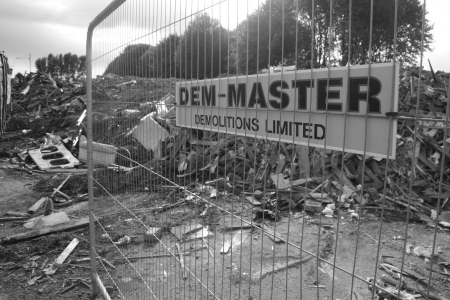
Image: Oatlands, part of the Clyde Gateway area
Central to Smith's argument is that the capital devalorisation and urban deterioration so typical of Hoyt's thesis is ‘a strictly logical, "rational" outcome of the operation of the land and housing markets.'24 Disinvestment in one area allows capital to be profitably invested elsewhere. Meanwhile, the devalorisation or ‘blight' associated with disinvestment produces the objective economic conditions that eventually make capital revaluation, or gentrification, a ‘profitable' market response. In the ‘disinvestment valley', Smith contends, arise the conditions that make possible the new urban frontiers of gentrification. The fate of those residents who have suffered for decades in this tortuously slow cycle of creative destruction has been to endure the wrath of territorial stigmatisation, deflecting critical enquiry away from previous policy and economic decisions, and providing a convenient alibi for ‘regeneration' and working class displacement.
Written in the Wind
In the context of Glasgow's urban topography, the Hoyt thesis should resonate with anyone who has ever walked through the ‘doughnut' of disinvestment around the city's former riverside industrial core.25 As inner city development spreads out from the city centre, development plans for the de-industrialised areas in the east of Glasgow can be seen in the context of a developing ‘rent gap' related to property expansion along the Clyde river corridor.26 As Smith suggests, these developments have less to do with the ‘hidden hand' of the market, and more to do with a series of identifiable private and public investment decisions at the service of the market. The high incidence of derelict land in the east of Glasgow, the socialisation of risks and costs in its remediation (essentially ‘geo-bribes' to lubricate capitalist investment), and its proximity to property development in the Merchant City and the near east of the city, make the area a prime, and primed, target for property developers.
Scottish government figures for 2006 claim the percentage of people living within 500 meters of any derelict site in Shettleston was 79.1 percent, while in nearby Calton the figure rises to a staggering 99.4 percent.27 These conditions reflect the successive failures of capitalist administrations to deal with some of the worst urban poverty in Britain. Yet the cause of these problems is typically mistaken. Glasgow City Council, a consummate agent of the neoliberal project, makes clear in the ‘City Plan' that vacant and derelict land alongside the Clyde development corridor represents ‘a significant development opportunity if appropriately remediated and marketed'. The Council will ‘continue to use its property and land portfolio to unlock development opportunities and stimulate the market.'28 To this end a £13.5 million Vacant and Derelict Land Fund programme - part of a £50 million ‘Better Glasgow' ‘regeneration' strategy - has been set up citywide to prime Council-owned sites this year for use by private developers and businesses. Moreover, regarding CG 2014, City Council leader Stephen Purcell has maintained that the Council will sell ‘surplus property and land' to meet the costs of hosting the event, while a Council spokesman said that land and property worth ‘hundreds of millions of pounds' was available for sale.29 The Council reportedly wants to ‘transfer' ‘56 surplus sites' to a new joint venture as part of the funding for the event.30
In case the business community is concerned that the current recession will curtail some of the Council's traditional largesse, Mr. Purcell has been at pains to assure it of the continuing loyalty of ‘Team Glasgow' to the crisis-ridden neoliberal project. Alongside promises of continued ‘flexibility' in terms of the disposal of publicly held land and assets, he told assembled guests at the recent State of the City Economy conference that Glasgow would remain ‘open for business':
My main priority is helping business in the city through the economic difficulties ahead [...]. The first thing that all public bodies, including my own Council, must do is to examine where we can help business by being more flexible and willing to do things differently. This is no time for unnecessary rules and processes; this is a time to do everything we can to help.31
All that Heaven Allows, or, All I (We) Desire?32
The ‘overarching purpose' of the Commonwealth Games 2014, the Games Interim Bid Legacy document reminds us, is to increase ‘sustainable economic growth'. This aim reflects the normalisation within regeneration discourses of the, now severely impaired, ‘moral capital' of private enterprise. Competition and the pursuit of wealth over recent decades have been routinely valorised as ends in themselves, with ‘trickle-down' effects supposedly guaranteed. Yet inter-urban competition, expressed through symbolic mega-events like the Commonwealth Games and large-scale regeneration projects, is, and always was, in reality a zero-sum game of ‘trickle up': the ‘external coercive power' of inter-city competition creates an accelerating race to the bottom, via the disposal of public assets and the exploitation of the labour force, in order to foster the ‘good business climate' which other cities also strive to achieve - in this way every city is merely brought further into line with the discipline and logic of capitalist development.33 The end results of this competitive schema are a banality:
Competition, as Marx long ago observed, always tends towards monopoly (or oligopoly) simply because the survival of the fittest in the war of all against all eliminates the weaker firms [...] [T]he fiercer the competition the faster the trend towards oligopoly if not monopoly.34
If experience shows us that neoliberal policies everywhere produce more poverty, more insecurity, and higher socio-economic inequality, the retreat to nostalgic forms of Fordist regulation is not a viable alternative in itself. In the face of de-socialised wage labour, precaritisation and generalised working poverty, Keynesian or ‘social democratic' modes of state intervention are likely to ‘stall, disappoint and eventually discredit themselves, paving the way for a further expansion of market rule.'35 In order to provoke a ‘crisis of legitimacy' in both neoliberal and Keynesian orthodoxy, attention might be better directed towards a more radical critique of the essential precondition of capitalist development - wage labour itself. What distinguishes radical practice from leftist, social democratic practice, after all, is precisely the difference between the struggle to mitigate alienation in the workplace through various measures, and the struggle to supersede alienation and the wage labour relation per se. However, most people still have to work, however precariously, and the workplace will continue to be the key site of solidarity in the struggle against capitalism. In order to avoid the perennial dichotomy of ‘reform' and ‘revolution', those involved in the struggle against capitalism might do well to engage the problem dialectically and agitate the once productive tension between minimum demands (for ‘fair' wage levels, working conditions, environmental conditions etc.) and maximum demands (the overthrow of capitalism and the alienating wage labour contract).
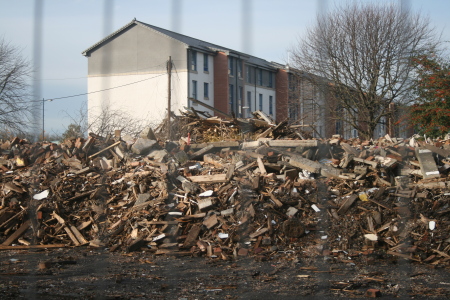
Image: Demolitions in Oatlands, edge of the Commonwealth Games site
The scale of developments in the East End of Glasgow, the symbolic weight attached to the wage labour contract through welfare reform, the inevitable increase in overall city unemployment, and the structural crisis of the capitalist economy mark it out as a key site from which to contest the fundamental contradictions of capitalism. A critical feature of this struggle should be to unmask the instrumental strategies behind the stigmatisation of the local population, and reject outright the ‘remedy' of workfare. Meanwhile, as the recession tightens its grip the spectre of Keynes is bound to loom large. But a challenge to capitalism which is not just limited to the ‘disjunctive synthesis' of representative democracy will have to question the tacit consensus behind the ownership and management of productive forces.36 Confining struggle to the sphere of distribution - in the probable form of banal service jobs, exploitative commodities, jerry-built housing, and the dreary spectacle of Bread and Circuses - won't be, and never has been, enough.
Neil Gray <neilgray00 AT hotmail.com> is a writer and film-maker based in Glasgow
Footnotes
1 See http://www.glasgow2014.com/2 See http://news.bbc.co.uk/1/hi/scotland/glasgow_ and_west/7086680.stm 3 Larissa E. Davies, ‘Sport and the Local Economy: The Effects of Stadia Development on the Commercial Property Market', Local Economy, Vol.23, No.1, February 2008, pp.31-46.4 Interim Games Legacy Plan for Scotland, 2008.5 'The need for such an initiative is evident from the concentration of economic, social and physical deprivation found in the area. It suffers from high levels of unemployment and low levels of economic activity; from social deprivation and poor health; and, from a concentration of derelict and contaminated land that blights the physical environment.' See http://www.southlanarkshire.gov.uk/coins/ commpdfs/public/1213.pdf 6 Neil Smith, The New Urban Frontier: Gentrification and the Revanchist City, Oxford: Routledge, 1996, Preface. See also, Neil Gray, ‘The Clyde Gateway: A New Urban Frontier', Variant Magazine, No. 33, Winter 2008, http://www.variant.random state.org/33texts/3_V33gray.html7 Ibid.8 For news of a very significant developer collapse in Edinburgh - and of the long resistance to said developers - see http://www.eh8.org.uk/ 9 See Rachel Weber, ‘Extracting Value From the City: Neoliberalism and Urban Redevelopment', in Spaces of Neoliberalism: Urban Restructuring in America and Western Europe, Oxford: Blackwell Publishing, 2002.10 See Ian Duncan Smith, ‘Living, and dying on welfare in Glasgow East', The Telegraph, 24 December 2008, http://www.telegraph.co.uk/com ment/3560470/Living,-and-dying,-on-welfare-in-Glasgow-East.html11 All quotes from research compiled by Gerry Mooney, ‘The Politics of Poverty and the Politics of Place: Reporting Glasgow East', forthcoming in Social Policy and Society, late 2009.12 In Shettlestone, the Scottish parliamentary constituency at the heart of Glasgow East, 34.9 percent of the population are ‘income deprived', with 30.1 precent ‘employment deprived', See http://www.sns.gov.uk/Reports/Report.aspx?ReportId=2&AreaTypeId=SP&AreaId=44 . In Dalmarnock, the site of the Games Village and National Indoor Stadium, in 2000, 48.9 percent of the population were incapacity benefit claimants, and 61.6 percent considered ‘economically inactive', Public Health Information manager, NHS Scotland.13 Ian Duncan Smith, op. cit.14 See http://www.guardian.co.uk/politics/2009/feb/ 16/freud-defects-labour-conservatives15 Iain Lundy, ‘My vision will bring the wow factor to East End', The Evening Times, 9 May 2008.16 See http://www.sundayherald.com/business/businessnews/display.var.2392683.0.full_of_east_end_promise.php17 The Glasgow City Council Plan, 2008-2011.18 See Neil Gray, ‘The Merchant City: An "Arts Led Property Strategy"', Variant Magazine, No. 34, Spring 2009.19 Andy Cumbers, Gesa Helms, Marilyn Keenan, ‘Beyond Aspiration: young people and decent work in the deindustrialised city', preliminary paper given at the Alternative Economic Strategy Seminar, ‘Good jobs, nae jobs, bad jobs: Skills, workfare and struggles over work', Glasgow, February 2009.20 Karl Marx, ‘The General Law of Capitalist Accumulation', Selected Writings, Oxford: Oxford University Press, 2001, p.517.21 Iain Lundy, ‘My Vision will bring the wow factor to East End', The Evening Times, 9 May 2008.22 Over the last ten years, the manufacturing sector in Glasgow has reduced by 31 percent to its current level of 6 percent. Meanwhile, the service sector now accounts for nine out of ten jobs in Glasgow.23 Neil Smith, The New Urban Frontier: Gentrification and the Revanchist City, Oxford: Routledge, 1996, pp.51-74.24 Ibid.25 See Anthony Iles, ‘Drifting Away From Reformist Politics in Glasgow', http://www.metamute.org/en/ drifting_away_from_reformist_politics_in_glasgow 26 ‘The rent gap is the disparity between the potential ground rent level and the actual ground rent level capitalized under the present land use', Neil Smith, op. cit.27 See http://www.sns.gov.uk/Reports/Report.aspx? ReportId=2&AreaTypeId=SP&AreaId=4428 See http://www.glasgow.gov.uk/en/Business/ City+Plan/ 29 See http://www.eveningtimes.co.uk/misc/print. php?artid=130680030 See http://scotlandonsunday.scotsman.com/business/Glasgow-will-struggle-to-sell.4260309.jp31 See http://www.glasgow.gov.uk/en/News/Archives/ 2008/November/stateofthecityeconomy2008.htm32 The section titles are from the films of Douglas Sirk - who charted the disjuncture between the surface vigour of capitalism (now imploding) and all that it obfuscates with glorious clarity.33 David Harvey, ‘From Managerialism to Entrepreneurialism: The Transformation in Urban Governance in late Capitalism', Geografiska Annaller, Vol.71, No.1, pp.3-17.34 David Harvey, ‘The Art of Rent: Globalisation, Monopoly, and the Commodification of Culture', 2002, http://socialistregister.com/recent/2002/harvey2002 35 Lois Wacquant, Urban Outcasts: A Comparative Sociology of Advanced Marginality, Cambridge: Polity Press, 2008, p.252.36 Michael Hardt and Antonio Negri, Multitude, London: Penguin Books, 2005, p.241.
Mute Books Orders
For Mute Books distribution contact Anagram Books
contact@anagrambooks.com
For online purchases visit anagrambooks.com


